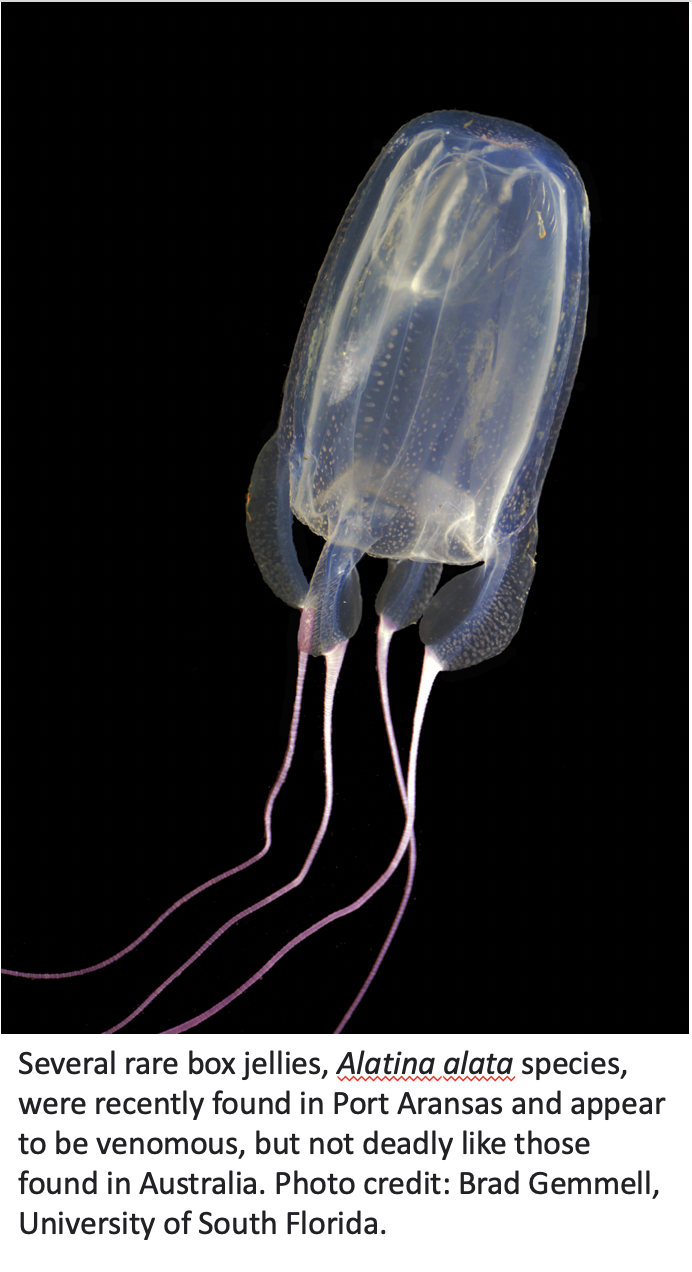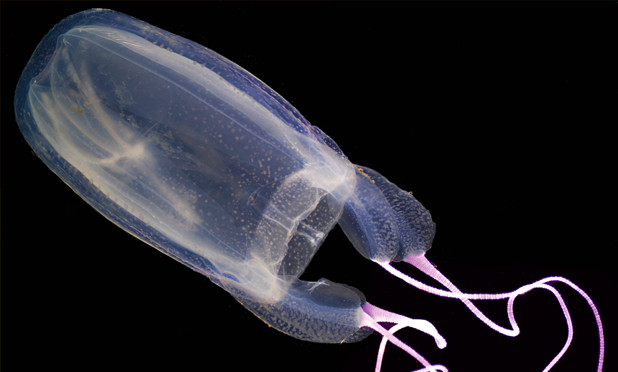 Scientific observations can happen when you least expect it. Dr. Brad Gemmell, a visiting alumni and Associate Professor at University of South Florida, and his mentor Dr. Edward Buskey, Interim Director at The University of Texas Marine Science Institute, were strolling along the Institute’s marina when they couldn’t help but notice a strange phenomenon. Several giant box jellies were swimming right at the surface, perhaps feeding on the large masses of smaller comb jellies or ctenophores that were present. This particular species of box jelly is found in tropical and subtropical waters worldwide, but is rare to the Gulf of Mexico and is usually only sighted far offshore. The scientists have identified it as Alatina alata, which is one of the largest species of box jellies with an average bell length of 10-inches. It can be easily identified from other jellies by the box-like shape and four purple tentacles that originate from each corner of the bell. While this species is related to the deadly box jelly species found in the Pacific and Indian Ocean, there have been no known deaths associated with the species, but literature indicates that a sting from its long purple tentacles can cause excruciating pain. We are unaware of any reports in the area or beaches of stings from this species.
Scientific observations can happen when you least expect it. Dr. Brad Gemmell, a visiting alumni and Associate Professor at University of South Florida, and his mentor Dr. Edward Buskey, Interim Director at The University of Texas Marine Science Institute, were strolling along the Institute’s marina when they couldn’t help but notice a strange phenomenon. Several giant box jellies were swimming right at the surface, perhaps feeding on the large masses of smaller comb jellies or ctenophores that were present. This particular species of box jelly is found in tropical and subtropical waters worldwide, but is rare to the Gulf of Mexico and is usually only sighted far offshore. The scientists have identified it as Alatina alata, which is one of the largest species of box jellies with an average bell length of 10-inches. It can be easily identified from other jellies by the box-like shape and four purple tentacles that originate from each corner of the bell. While this species is related to the deadly box jelly species found in the Pacific and Indian Ocean, there have been no known deaths associated with the species, but literature indicates that a sting from its long purple tentacles can cause excruciating pain. We are unaware of any reports in the area or beaches of stings from this species.
Drs. Gemmell and Buskey are no stranger to unforeseen discoveries of natural phenomena. When Dr. Gemmell was a graduate student in Port Aransas, he and Dr. Buskey saw swarms of copepods jumping out of the water at the very same marina in which the box jellies were observed. The initial observations led to a study published in Proceedings of Royal Society Journal, which Science.org reported that the small planktonic copepods can are considered some of most athletic creatures ever recorded when they leap at 40 times their body length from the water to evade predators.
Upon finding the box jelly, Dr. Gemmell who studies locomotion in marine organisms, immediately put the jelly in a tank to measure how such a large box jelly moves through the water with such high speeds. Initially, the data shows that this large box jelly can swim faster than any of species of jellyfish using jet propulsion that appears to differ somewhat from its smaller relatives. The pulsation of the bell and resulting jets also creates vortex rings that may help entrain prey into the potent tenacles.
Despite being at the UT Marine Science Institute to deliver a scientific seminar to his alma mater, Dr. Gemmell is never one to pass up an opportunity to make observations in the natural environment. In this case, he is hopeful that a chance encounter will lead to a greater understanding of how these rare animals propel themselves so effectively through the water and may even provide insights than can be used for future designs of underwater vehicles.









